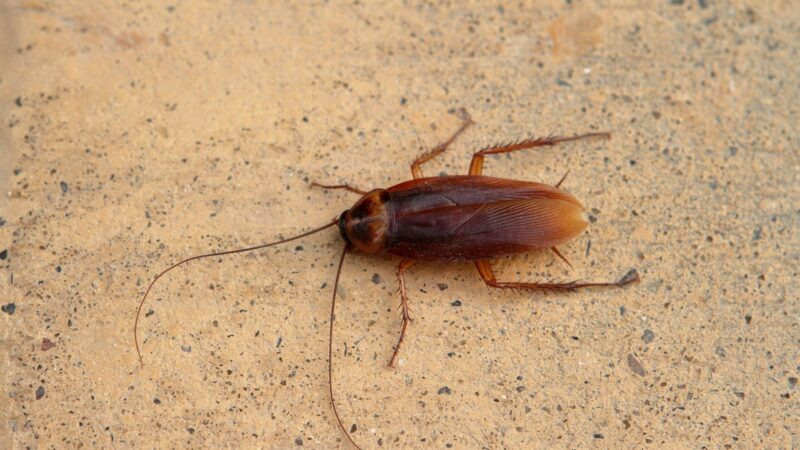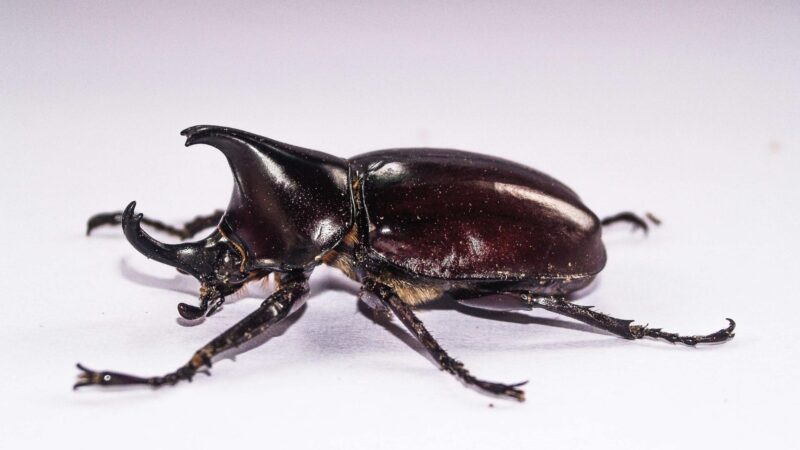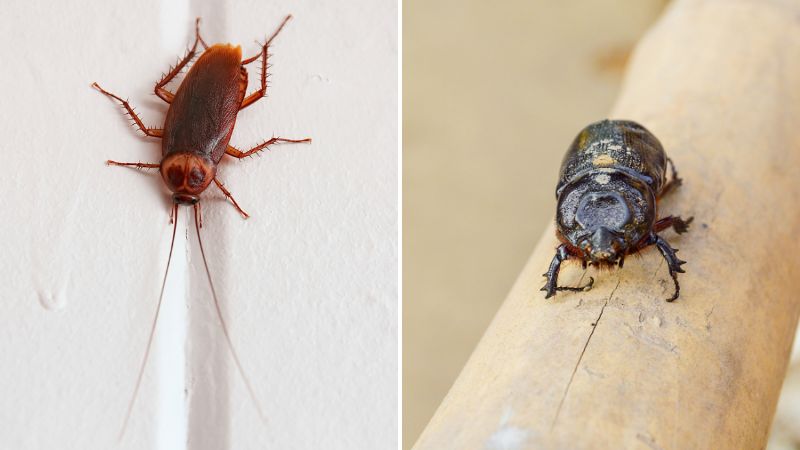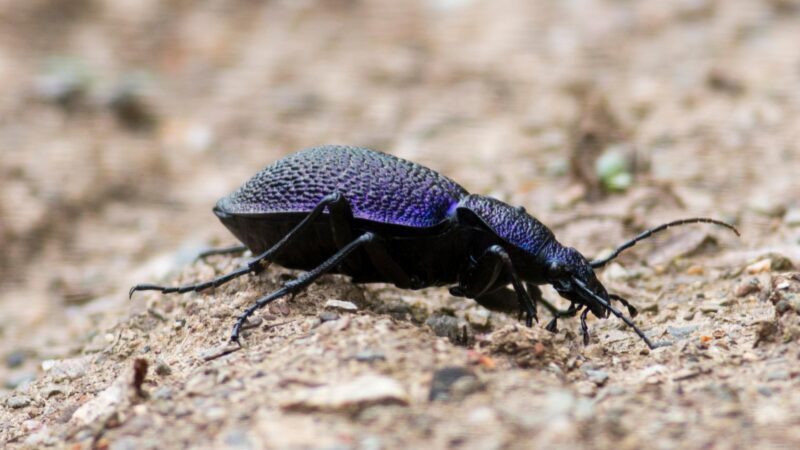Cockroaches are notorious household pests, while beetles are usually thought of as being only outdoors. But since both of them are rarely seen in the daytime, you might mistake one for the other. Therefore, it’s important to make the distinction.
So, how do you tell if it’s a beetle or cockroach in your house? In short, if the insect runs so fast once you make a sudden movement, then it is a cockroach. If it tries to fly, it is likely a beetle. Roaches are a bit bigger than beetles, and they have flat bodies and long antennae.
This comprehensive article can serve as a guide for you to identify whether the creepy crawly you have is a cockroach, beetle, or something else entirely. Read further for more!
Cockroach Identification

Cockroaches can be black, brown, or reddish-brown and come in different sizes, depending on the species. All roaches have compound eyes, long antennae, six spiny long legs, and flat, oval bodies covered with a hard shell (or exoskeleton). Adult roaches can grow between ½ inch and 2 inches long.
Young roaches (or nymphs) look the same as the adults, except that they are smaller and have no wings. Male adults have two pairs of wings, but only a few of them can fly. Most females are wingless or have very small wings and cannot fly.
Roaches can easily be identified through their full-body wings. In short, there is no visible gap between their head, thorax, and abdomen. Their abdomen has 10 noticeable segments, while their head is covered with a big shield structure called pronotum. When viewed from above, their heads are somehow hidden.
Related: What Is a Cockroach? | Information and Facts
Beetle Identification

Beetles also come in different sizes, depending on the species. They can be black, blue, brown, gold, green, orange, or red, and usually have bright colors. Some beetle species have stripes or marks or a combination of colors. Beetles have short antennae and chewing mouthparts, but some have huge piercer jaws.
Beetles have cylindrical, segmented bodies, wherein you can easily notice the separation between their head and thorax. They also have a hard head and two pairs of wings. Although most beetle species can fly well, some are flightless because their veinless and hard forewings meet and are fused to their bodies.
All beetle species have compound eyes in front of their head and six short legs that have no hard spikes. Each foot has a pair of short but sharp claws and seems to be bending towards its body. Adults can grow up to 6.5 inches long. Immature beetles are called larvae, which are worm-like grubs with true legs.
What Is the Difference Between a Cockroach and a Roach?
Aside from physical appearance, their life cycle, eating habits, behavior, and habitat are also not the same. Here are the major differences between a cockroach and a beetle:
1. Life Cycle
Cockroaches undergo incomplete metamorphosis, which means they pass through three life stages: egg, nymphal, and adult. Female roaches lay a dark-colored, bean-sized egg case called ootheca. Each egg capsule can contain 15-50 individual eggs. These eggs hatch into nymphs usually from 20 to 60 days.
Meanwhile, beetles undergo complete metamorphosis, which means they pass through four life stages: egg, larval, pupal, and adult. Female beetles lay eggs, which hatch into larvae within 7-10 days. Beetle larvae will start to eat and molt about 15 times before they pupate then emerge as adults.
2. Eating Habits
Cockroaches are not picky eaters and eat almost anything available except for metal. This includes human food, human and animal waste, fingernails, garbage, glue, grease, hair, toothpaste, and even their dead comrades. They may also eat their eggs and nymphs if food is unavailable.
On the other hand, most beetle species eat plant parts such as flowers, fruits, leaves, and seeds. Some species feed on other insects (dead or alive), spiders, and snails. Adults and larvae of Epomis beetles (a type of ground beetle) eat frogs. This beetle species behaves like a parasite and eat live frogs to death.
Moreover, cockroaches are considered generalist omnivores, since they are able to survive on a variety of food items. Whereas beetles may either be specialists (with specific diets) or generalists, depending on the species.
3. Behavior
Contrary to what many people think, cockroaches are not afraid of humans. They don’t mind approaching people but will run away once a person makes a sudden movement. Amazingly, they can run up to 3 miles per hour. They can also survive for a month without food and a week without a head.
Unlike roaches that usually escape from predators instead of fighting back, most beetle species defend themselves with their powerful mandibles. Beetles don’t attack humans but may bite when threatened. Some species, such as Blister beetles and Bombardier beetles release chemicals that cause skin irritation.
4. Habitat
Cockroaches live in a very wide range of environments but prefer dark, wet, and warm areas. They are attracted to moisture and standing water. In most cases, you can find them in leaky pipes, floor drains, damp basements, and sewer systems. As scavengers, roaches can also be found in open trash cans.
Beetles also have different habitats. Most species live in gardens, vegetation, and rainforests. They can also be found near water, in the desert, and beneath the ground. Adult beetles rarely live indoors, but they enter houses and buildings to find food and shelter and to lay eggs.
What Are the Distinct Similarities Between Beetles and Cockroaches?

Although cockroaches and beetles have very obvious differences, they are also similar in some ways. But again, you need to observe them closely. Here are some of the distinct similarities between roaches and beetles:
1. They walk with a tripod gait.
Since beetles and cockroaches have three pairs of legs, both of them walk with an alternating tripod gait. While walking, three pair of legs on one side touch the ground, and the three other legs on the other side are off the ground. Cockroaches run faster than beetles, but the latter are better fliers.
2. They are both nocturnal insects.
Both insects are primarily nocturnal, which means that they hide in dark places during the day. This behavior not only protects them from predators but also from humans. However, it does not necessarily mean that they are afraid of the light. In fact, some species are attracted to light.
3. They are both social insects.
Both cockroaches and beetles are generally social insects and tend to travel in groups. But then, don’t be surprised if you see a lone roach or beetle inside your house—others may be hiding somewhere. Otherwise, the insect you saw accidentally entered through a small gap or a broken window screen.
4. Both of them don’t build nests.
Unlike ants and bees, roaches and beetles don’t build nests. Instead, they move tirelessly from one place to another to look for food. Some beetle species use a rodent and bird’s nest, while roaches release pheromones to invite others to join them.
Is There a Beetle That Looks Like a Cockroach?

There are some beetle species that look like cockroaches. They are the following:
- Ground beetle (Carabidae)
- June beetle (Phyllophaga)
- Longhorn beetle (Cerambycidae)
- Palo Verde beetle (Derobrachus hovorei)
- Wood boring beetle (Buprestidae)
Are Beetles and Cockroaches Poisonous to Dogs?
Beetles and cockroaches are not poisonous to dogs since both insects don’t have poison inside their bodies. Although roaches carry lots of germs, dogs can eat them without getting sick. But then, blister beetles (Meloidae) release a toxin called cantharidin that causes stomach upset to dogs and is deadly to horses.
Signs of Cockroach Damage
The damages due to cockroaches include tear-off paper, clothes, plastic, as well as smear marks. Meanwhile, symptoms of infected people include chills, fever, headache, stomach cramps, nausea, vomiting, and blood in the stool. In worst cases, it can lead to dehydration, which may require hospitalization.
What Damages Can Cockroaches Cause?
Cockroaches can damage some belongings, including leather, books, papers, and clothes. Their feces, saliva, and cast skins can cause skin irritation, watery eyes, and can asthma, especially in young children. Although roaches don’t bite or sting, they can contaminate food, kitchen utensils, and other items.
Getting into contact with contaminated items can lead to intestinal diseases such as cholera, diarrhea, dysentery, food poisoning, gastroenteritis, and typhoid fever. When bacteria get into food and are swallowed, patients can suffer from E. coli infection, salmonellosis, staphylococcus infection, and streptococcal infection.
Signs of Beetle Damage
The damages due to beetles in the garden include fallen twigs, chew and bite marks on fruits, irregular holes in leaves, brown leaves, and other plant diseases. When indoors, signs of damage due to beetle larvae include smashed dry food packages, spill-out dust, and infested foods that can no longer be eaten or sold.
What Damages Can Beetles Cause?
Most beetle species don’t bite, sting, or carry diseases. Meanwhile, their larvae are considered destructive pests. Beetle larvae can cause severe damage to plant-based materials such as fabric, leather, and carpets. Some species, such as drugstore beetles, are pantry pests and eat dry food, especially grains and seeds.
Beetles vs. Cockroaches | Which Is Easier to Kill?
Generally speaking, cockroaches are harder to kill than beetles. This is because they run faster and have a hard exoskeleton. As mentioned earlier, they can still live for a week despite being headless. Also, a 2019 study suggested that the German cockroach has become more resistant to some insecticides.
Does Roach Spray Kill Beetles?
A roach spray can also kill beetles, but it depends on the product. Some products, such as Raid Ant & Roach Killer Spray , are designed not only to kill roaches. They can also eliminate ants, carpet beetles, multicolored Asian lady beetles, and spiders. However, these sprays should not be used on food items.
- Raid Ant & Roach kills a wide variety of insects including...
- Kills on contact and keeps killing with residual action for up to...
- Ant & Roach spray with no lingering chemical odor
- Easy-to-use ant & roach killer that can be applied to surfaces...
- Retreat with ant & roach killer every 4 weeks as necessary to...
How to Prevent Serious Beetle and Cockroach Problems?
Preventing serious problems with beetles and cockroaches is quite challenging. But now that you know their eating habits and behavior, you already have some clues on how to avoid them. Despite the differences between these pest insects, most preventive measures against them are the same.
Here are some of them:
1. Don’t Let Them In
Seal all possible entry points, including cracks and crevices. For better sealing of doors and gaps around walls, you can use Vitam Amo Weather Stripping Seal Strip . If you have broken window screens, replace them immediately. Check dry food packages for holes and damages before bringing them inside your house.
- SEAL AND KEEP OUT UNWANTED WIND, WATER, LIGHT AND SOUND! - The...
- EPDM MATERIAL! This sealing strip is made of VITAM AMO's...
- A QUICK SOLUTION! NO TOOLS OR EXPERIENCE REQUIRED - The length of...
- SPECIAL SOUNDPROOF HOLES DESIGN - VITAM AMO sealing strip has a...
2. Eliminate Food Sources
Since dry foods such as grains and seeds are part of beetle larvae’s diet, store them in tightly-closed containers. Also, seldom-used carpets and fabric should be kept in insect-proof cabinets.
To prevent cockroaches, don’t leave them on the table, and keep your kitchen dry. Fix leaky pipes and avoid having standing water.
3. Regular Inspections and Cleaning
Cockroaches and beetles are stubborn pests, so inspection and cleaning should be done regularly. Empty and cover garbage cans every night. Check dark areas such as attics for dead insects or rats, animal poop, and insect skin. More importantly, vacuum every corner of the house at least once a week.
These household pests are not only disgusting to look at; the damages they bring could also be costly and dangerous to health. Not to mention they can be present even if your house is clean. This is why actions taken should be done consistently.
Related: How to Get Rid of Cockroaches? | Proven Strategies & Solutions!
List of Sources
McPherson, S., Wada-Katsumata, A., Hatano, E., Silvermann, J., & Schal, C. (2021). Comparison of Diet Preferences of Laboratory-Reared and Apartment-Collected German Cockroach.
Potter, M. F. (2018). Cockroach Elimination in Homes and Apartments.
Smithsonian Institution. (n.d.). Beetles (Coleoptera).
University of Arkansas Division of Agriculture. (n.d.). Blister Beetles.
University of Massachusetts Amherst. (2016). The Cockroach FAQ.
- How to Get Rid of Cockroaches? | Proven Strategies & Solutions! - June 24, 2023
- Powerful Homemade Wasp and Bee Sprays (with Recipes) - March 4, 2023
- Crazy Ants Invasion | Eradicate & Prevent Unwanted Guests - February 24, 2023


